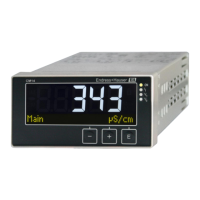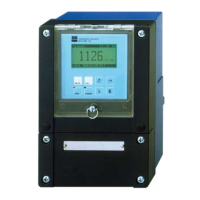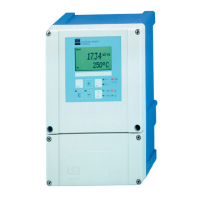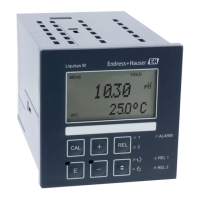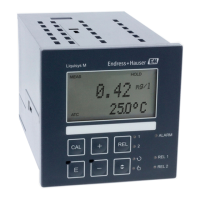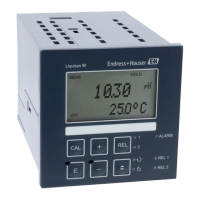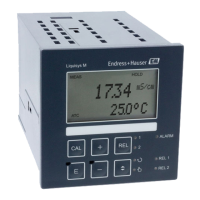What to do when sensor electronics are defective in Endress+Hauser CM14?
- DDavid Schultz DDSSep 12, 2025
If the sensor electronics are defective in your Endress+Hauser Transmitter, replace the sensor. If the issue continues, contact service.

What to do when sensor electronics are defective in Endress+Hauser CM14?
If the sensor electronics are defective in your Endress+Hauser Transmitter, replace the sensor. If the issue continues, contact service.
How to fix no calibration data present error on Endress+Hauser CM14?
If there is no calibration data present on your Endress+Hauser Transmitter, carry out airset calibration.
How to troubleshoot no measured value displayed on Endress+Hauser CM14 Transmitter?
If there is no measured value displayed on your Endress+Hauser Transmitter, first check the power supply to the device. If the power is supplied and the issue persists, the device may be defective and require replacement.
What to do if there is no sensor communication with Endress+Hauser CM14 Transmitter?
If your Endress+Hauser Transmitter is showing no sensor communication, you should: * Check the sensor cable connection. * Check the sensor cable for a short-circuit. If these steps don't resolve the issue, the sensor may need to be replaced. If the issue persists after replacing the sensor, or if the sensor firmware update was canceled with an error, contact service.
Why is the sensor data invalid on my Endress+Hauser CM14 Transmitter?
If you are experiencing invalid sensor data with your Endress+Hauser Transmitter, try updating the date of the transmitter. If the issue continues, the sensor may need to be replaced.
How to fix no conductivity display on Endress+Hauser CM14?
If your Endress+Hauser Transmitter shows no conductivity display, first check the sensor installation to ensure it is not in the air. If the sensor is properly installed and the issue persists, the sensor may be defective and require replacement.
What to do if my Endress+Hauser CM14 has no measured value display?
If your Endress+Hauser Transmitter isn't showing any measured values, there could be a couple of reasons. First, check the power supply to ensure the device is properly connected and receiving power. If the power supply is fine and the device is still not displaying values, it may be defective and need to be replaced.
What to do if conductivity limit value for USP exceeded on Endress+Hauser Transmitter?
To address a conductivity limit value for USP that has been exceeded on your Endress+Hauser Transmitter, check the process.
What causes a sensor self-test error on Endress+Hauser CM14?
If you are experiencing a sensor self-test error with your Endress+Hauser Transmitter, replace the sensor. If the issue persists, contact service.
What causes poor energy supply to sensor in Endress+Hauser Transmitter?
If there's a poor energy supply to the sensor on your Endress+Hauser Transmitter, check the cable connections. If the problem persists, replace the sensor.
| Manufacturer | Endress+Hauser |
|---|---|
| Type | CM14 |
| Category | Transmitter |
| Measurement principle | Conductivity |
| Input signal | Conductivity sensor signal |
| Output signal | 4 to 20 mA |
| Protection class | IP65 |
Safety precautions for working with the device, including PPE and wet hand precautions.
Qualifications and authorization needed for personnel performing installation, commissioning, diagnostics, and maintenance.
Ensuring proper technical condition and fail-safe operation of the device; operator responsibility.
Device's purpose: evaluating analytical sensor values, process monitoring/control, panel installation.
Manufacturer's right to update technical details; contact sales center for modifications.
Procedure for returning the device for repair, including packaging and documentation.
Explains warning symbols (DANGER, WARNING, CAUTION, NOTICE) and document symbols used in the manual.
Information about identifying the device, including the nameplate details and diagram.
Lists the components included in the transmitter's delivery package.
Details on CE mark and EAC mark, confirming product compliance with directives and guidelines.
Procedures for receiving, handling, and storing the device safely and correctly.
Guidelines for installing the transmitter, including panel mounting and ambient temperature.
Specifications for the device's physical size, panel cutout, and thickness.
Step-by-step instructions for mounting the device into a panel using the provided frame and rods.
Checklist of essential verification steps after the device has been installed in the panel.
Detailed instructions and diagram for wiring the transmitter's terminals to sensors and power.
Checks to perform after connecting the device, covering device condition and electrical connections.
Explanation of the device's display sections, status LEDs, and their meanings.
How to operate the device using the three integrated front panel keys.
Explanation of symbols displayed during operation and used in editing mode, including status and editing icons.
Overview of the device's main operating menus: Display, Setup, Calibration, and Diagnostics.
Description of the hold function, its activation, and effect on outputs and display.
Steps for initial device setup after installation, including checks and power-on.
How to adjust display parameters like contrast, brightness, and alternating time.
Instructions for locking the device setup and calibration functions with an access code.
Guide to configuring essential device settings such as Tag and current range via the Setup menu.
Details on advanced settings for system, tag, temperature units, and more via the Extended Setup menu.
How to configure the device's two relays, including assignment, limits, and hysteresis.
Explanation of the installation factor's purpose and how it compensates for pipe wall effects.
How conductivity is affected by temperature and methods for compensation.
Configuration of relays for USP/EP pharmaceutical water, including temperature-dependent limit values.
Accessing and interpreting diagnostic information, including current/last messages and device details.
Definition of calibration and its purpose in ensuring measurement accuracy.
How to access and perform calibration procedures for conductivity and temperature.
Detailed steps for calibrating the cell constant using reference solutions.
Information regarding maintenance requirements for the device.
List of available conductive and inductive conductivity sensors, with technical information references.
General warnings and advice for troubleshooting, emphasizing safety precautions.
Explanation of diagnostic message codes (F, M, C, S) and their meanings.
Details of firmware versions, changes made, and release dates.
Illustration and item numbers for available spare parts for the device.
Specifications related to the device's input signals, measured variables, and input types.
Technical specifications for the device's output signals, including analog and alarm outputs.
Detailed electrical and cable specifications for the active current outputs.
Specifications for relay types, switching capacity, and cable requirements.
Electrical connection diagram and terminal assignments for wiring the device.
Information on the power supply voltage, consumption, and circuit breaker requirements.
Details on response time and reference temperature for device performance.
Information on maximum measured error, current output resolution, and repeatability.
Guidelines for installing the device, including panel cutout dimensions and orientation.
Details on operating height, electromagnetic compatibility, degree of protection, and humidity.
Information on the device's mechanical dimensions, materials, and terminals.
The weight of the device and the materials used for its housing and front foil.
Technical specifications for the device's terminals, including wire size and torque.
Description and illustration of the device's display, status LEDs, and operating keys.
Details on CE mark and other standards/guidelines the product complies with.
